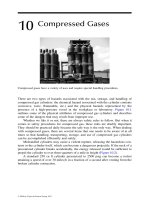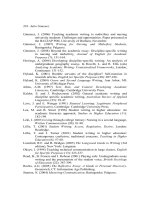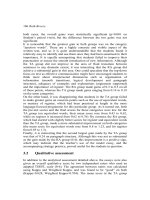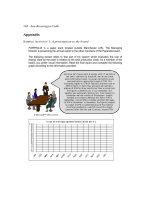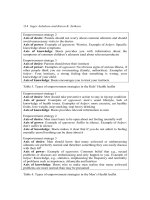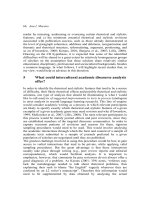English for Professional and Academic Purposes phần 10 doc
Bạn đang xem bản rút gọn của tài liệu. Xem và tải ngay bản đầy đủ của tài liệu tại đây (979.05 KB, 28 trang )
Julio Gimenez
210
Gimenez, J. (2006) Teaching academic writing to midwifery and nursing
university students: Challenges and opportunities. Paper presented at
the BALEAP PIM, University of Durham, November.
Gimenez, J. (2007) Writing for Nursing and Midwifery Students,
Basingstoke: Palgrave.
Gimenez, J. (2008) Beyond the academic essay: Discipline-specific writing
in nursing and midwifery, Journal of English for Academic
Purposes (7): 151-164.
Hewings, A. (2004) Developing discipline-specific writing: An analysis of
undergraduate geography essays. In Ravelli, L. and R. Ellis (eds)
Analysing Academic Writing: Contextualised Frameworks, London,
Continuum: 131-152.
Hyland, K. (2001) Humble servants of the discipline? Self-mention in
research articles, English for Specific Purposes (20): 207-226.
Hyland, K. (2004) Genre and Second Language Writing, Ann Arbor, MI:
University of Michigan Press.
Johns, A.M. (1997) Text, Role, and Context: Developing Academic
Literacies, Cambridge: Cambridge University Press.
Kaldor, S. and J. Rochecouste (2002) General academic writing and
discipline specific academic writing, Australian Review of Applied
Linguistics (25): 29-47.
Lave, J. and E. Wenger (1991) Situated Learning: Legitimate Peripheral
Participation, Cambridge: Cambridge University Press.
Lea, M. and B. Street (1998) Student writing in higher education: An
academic literacies approach, Studies in Higher Education (11):
182-199.
Leki, I. (2003) Living through college literacy: Nursing in a second language,
Written Communication (20): 81-98.
Lillis, T. (2001) Student Writing. Access, Regulation, Desire, London:
Routledge.
Lillis, T. and J. Turner (2001) Student writing in higher education:
Contemporary confusion, traditional concerns, Teaching in Higher
Education (6): 57-68.
Lunsford, R.F. and B. Bridges (2005) The Longwood Guide to Writing (3rd
edition), New York: Longman.
Okoye, I. (1994) Teaching technical communication in large classes, English
for Specific Purposes (13): 223-237.
Read, B., B. Francis and J. Robson (2001) Playing safe: Undergraduate essay
writing and the presentation of the student voice, British Sociology
of Education (22): 387-399.
Rocha, A.G. (2005) The Reflective Essay: A Guide to Personal Discovery.
Greenwich, CT: Information Age Publishing.
Stanton, N. (2004) Mastering Communication, Basingstoke: Palgrave.
Academic writing in the disciplines 211
Swales, J.M. (2004) Research Genres: Exploration and Applications,
Cambridge: Cambridge University Press.
Thompson, P. (2006) A corpus perspective on the lexis of lectures, with a
focus on Economics lectures. In Hyland, K. and M. Bondi (eds)
Academic Discourse across Disciplines, Bern: Peter Lang: 253-270.
Whitehead, D. (2002) The academic writing experiences of a group of
student nurses: A phenomenological study, Journal of Advanced
Nursing (38): 498-506.
Womack, P. (1993) What are essays for?, English in Education (27): 42-59.
Zhu, W. (2004) Writing in business courses: An analysis of assignment types,
their characteristics, and required skills, English for Specific
Purposes (23): 111-135.
Acknowledgements
I am indebted to all the participants in this study. Without their participation,
input and generosity, this project would have never been possible.
English language education
for science and engineering students
Thomas Orr
This chapter provides an introduction to English for Science and Engineering (ESE)
not only for those who may be interested in developing an ESE program but also for
those who may be interested in pursuing ESE as a career. It contains explanations of
ESE work, descriptions of successful practice, attributes of an ideal practitioner, and
a detailed profile of one representative program.
1 Introduction
Science and engineering are global disciplines, with English being the
language of preference for top international conferences and scholarly
publications as well as for communication among international employees in
the workplace and on international project teams. Competence in the English
of scientific and technical work is essential for success, not only for native
speakers, but also for nonnative speakers, who comprise the vast majority of
professionals in scientific and engineering fields. Schools of science and
engineering know this fact and continually search for better ways to improve
the English skills of their students, but specialists in English for Specific
Purposes (ESP) who possess the appropriate knowledge, skills, and interests
to contribute significantly to this work, unfortunately, are in very short
supply.
The intent of this chapter is to help alleviate this problem by offering some
helpful perspectives and guidelines to university students and mid-career
professionals who might be persuaded to pursue a career in English language
education for Science and Engineering (ESE)
1
. As a university administrator
who recruits and hires professionals in ESE; who lectures frequently to
science and engineering faculty about ESE; and who routinely seeks
competent science/engineering English experts for research projects,
conference keynotes, publication review committees, and consultation
opportunities, I am continually troubled by the enormous gap between human
supply in ESE and world demand. If this chapter can help to increase both
interest and competence in the work of English language instruction for
1
Historically, English for science and engineering has been called EST (English for Science and
Technology) in the ESP literature; however, in this chapter engineering will be used instead of
technology since, currently, the greatest plea for effective academic and professional English
instruction in these disciplinary domains comes from the engineering community which prefers
to be labeled as engineering rather than labeled as technology.
Thomas Orr 214
science and engineering, this will advance the field of ESP and the science
and engineering disciplines in equally positive ways.
Before we begin, however, it would be best for me to note that English
language instruction for native speakers (NS) and nonnative speakers (NNS)
will not be strongly differentiated in this chapter, since both groups are
frequently expected to possess similar levels of competence in English but
merely bring different domains of experience and training with them to the
university when they matriculate. Some of the instruction proposed on the
following pages will be better suited for novices in the professional English
discourse of science and engineering, and other instruction for the more
proficient, but expertise in English communication does not divide cleanly
between native and nonnative speakers in technical fields, which often attract
students surprisingly weak in all forms of social and professional interaction,
even when communicating in their native language. Consequently, no
particular distinction will be made between learners beyond those with
different kinds of learning needs. As ESP continues to evolve, it seems
probable that the field will eventually expand its sphere of interest to include
addressing the specific English learning needs of both native and nonnative
speakers at whatever levels of English require professional assistance.
2 Ideal interests and abilities for successful instruction
Language education has been around for a very long time, producing not only
generation after generation of successful (and not so successful) language
users but also a very large archive of knowledge about what ought to be done
to enable language acquisition to occur. In the context of ESE, professional
literature in ESP (e.g., Dudley-Evans, 1998), ESL (e.g., Tsui, 2003), general
higher education (e.g., Fink, 2003; Bain, 2004; Sawyer, 2006; Biggs and
Tang, 2007) and higher education for science and engineering (e.g., Reis,
1997; Baillie and Moore, 2004; Kalman, 2008) can be used to build a profile
of what might be called the ideal educator for the ESE profession. Naturally,
no one is born with all of these characteristics. But having a clear view of
what the ideal might look like provides a much better professional target for
educators who are thinking of developing some professional expertise in this
field. In fact, scholarly research on expertise and expert performance
(Ericsson et al., 2006) supports this assertion with multiple examples from
the cognitive sciences which show that people who become experts have
much clearer mental images of what expertise in their professional domain
actually entails than long time novices, who perhaps wish to become experts
but typically possess no more than vague notions of how genuine
professionals actually think and act.
English language education for science and engineering students 215
3 Profile of an ideal educator in ESE
General Professional Interests
• Interest in knowledge, learning, and personal improvement
• Interest in people and in helping them with their own personal
improvement
Specific Professional Interests
• Interest in human language and communication
• Interest in math, science, engineering, and other relevant fields
• Interest in the learning sciences (cognitive science, educational
psychology, sociology, education, instructional design, etc.)
General Professional Abilities
• Ability to identify essential knowledge, learn it, and apply it
• Ability to identify problems, understand their causes, and generate
successful solutions
• Ability to communicate, build positive relationships, and work well
with others
Specific Professional Abilities
• Ability to understand the culture, activities, and English of science
and engineering
• Ability to identify the English and supporting attitudes and behavior
that make work successful in science and engineering
• Ability to determine where students are lacking in these areas
• Ability to select or design appropriate instructional content and
supporting instructional methods
• Ability to deliver the instruction effectively and get good results
• Ability to assess learner progress and respond with helpful feedback
• Ability to evaluate instruction and continually make improvements
• Ability to work productively with administrators, educators, and
others involved in the work
One thing that this profile cannot do is specify the amounts of interest,
knowledge, or ability that are needed to assure there will be successful results
from one’s efforts. However, it may be reasonable to assume that the more
one has the better one will perform, although success in some educational
contexts may require no significant amount of interest or ability at all.
Necessary amounts of professional expertise in different areas depend
heavily on local circumstances.
Thomas Orr 216
4 Descriptions of English language need
One of the most noticeable elements of professional practice in ESP is needs
analysis, a set of carefully designed procedures for determining what
specifically needs to be learned in what specific way. In regard to the English
language learning needs of university students majoring in science or
engineering, it should be noted that curriculum designers, materials
developers, and instructors can benefit from the considerable amount of
knowledge that scholars, practitioners and authorities have already identified
as essential learning needs based upon their own professional perspectives.
Naturally, different learners in different contexts aiming at different skill sets
will require different instructional content and learning activities, but
incorporating the recommendations of those who support science and
engineering professionally will help create far richer, more effective
instruction than can be obtained from personal observations or the ESP
literature alone. What do authorities identify as essential language-related
learning needs for students in science or engineering? Here are a few
representative examples.
According to ABET, Inc. (2008: 2), the world’s largest accreditation board
for quality assurance in applied science, computing, engineering, and
technology education, engineering programs must demonstrate that their
students attain the following outcomes by graduation if their programs expect
to qualify for accreditation:
• an ability to apply knowledge of mathematics, science, and
engineering
• an ability to design and conduct experiments, as well as to analyze
and interpret data
• an ability to design a system, component, or process to meet desired
needs within realistic constraints such as economic, environmental,
social, political, ethical, health and safety, manufacturability, and
sustainability
• an ability to function on multidisciplinary teams
• an ability to identify, formulate, and solve engineering problems
• an understanding of professional and ethical responsibility
• an ability to communicate effectively
• the broad education necessary to understand the impact of engineering
solutions in a global, economic, environmental, and societal context
• a recognition of the need and an ability to engage in life-long
learning
• a knowledge of contemporary issues
• an ability to use the techniques, skills, and modern engineering tools
necessary for engineering practice.
English language education for science and engineering students 217
Although all of these activities require skill in special modes of language,
item D requires students to be able to communicate both technical and
nontechnical information to other people on a project team who may not be
familiar with some of the vocabulary or concepts being discussed. Therefore,
ESE in some contexts might need to train students to be sensitive to the
linguistic and disciplinary knowledge of different audiences as well as equip
students with the English language skills that are needed to speak or write at
a variety of different levels of complexity in order to convey their messages
successfully. This would include the ability to comprehend English messages
expressed in different accents and levels of language proficiency as well as
the ability to respond appropriately. Scientists and engineers nearly always
work in teams, and it is increasingly common these days, thanks to the
Internet, for team membership to not only be multidisciplinary but equally
international both in terms of nationality and work location.
Item G, the ability to communicate effectively, extends the need for
competence in English to include all aspects of spoken and written
communication that are required to connect professionally with others for all
of the academic and professional purposes that characterize a student’s field.
Since faculty and administrators must demonstrate to ABET what
communicative tasks require student proficiency, along with evidence that
students have actually attained it, it is best for ESE specialists and
engineering/science faculty to work together to create language training
programs that can satisfy the accreditation demands of ABET or any other
accreditation board or government ministry that the university may have to
answer to. English proficiency standards that may satisfy specialists in ELT
may not be sufficient to satisfy the expectations of science and engineering
departments, where English needs differ from the language skills normally
measured by popular assessment tools, such as the International English
Language Testing System (IELTS) or the Test of English for International
Communication (TOEIC).
In addition to accreditation boards and government agencies that may specify
particular English requirements for schools of science and engineering,
practitioners also have opinions about what students need to learn in school,
based upon their own experience with university learning and its usefulness
(or not) in preparing them to succeed in the workplace. A frequently cited
survey (Middendorf, 1980) of 4,057 working engineers, for example,
generated a list of 38 skill areas recommended for development – eight of
which specifically involve communication and all of which rank in the top
ten of all the skills on the list:
• Management
• Technical writing
• Probability and statistics
Thomas Orr 218
• Public speaking
• Creative thinking
• Working with individuals
• Working in groups
• Speed reading
• Talking with people
• Business practices (e.g., marketing)
• Computer use, etc.
Additionally, university administrators, such as science and engineering
school deans, also have ideas about language-related requirements for their
students in science or engineering. Out of ten recommendations for
engineering school reform proposed by James Plummer, Dean of Engineering
at Stanford (LaPedus, 2008), three of them (recommendations 4, 7, and 8)
deal specifically with competence in English:
4. Engineering schools must teach students how to work well as a member of
a diverse team (i.e., diverse in expertise, culture, and language).
7. Engineering schools must provide global knowledge and experience
(e.g.,
Stanford offers summer internships in companies worldwide).
8. Engineering schools must teach better communication skills
.
Parallel to the requirements of ABET, Plummer recommends better training
for English communication among professionals of diverse language, cultural
and professional backgrounds, that not only includes all of the standard
spoken and written discourse for academic and professional purposes, but
also includes sufficient knowledge and experience using English at work in
different global contexts which would logically require skill in cross-cultural
communication.
Calls for better English language use in science and engineering – along with
specifics about what kind of language that includes, as well as some rather
excellent training materials to facilitate its mastery – can also be found at the
websites of professional societies in science and engineering, and in their
professional newsletters, magazines, and journals.
The American Society for Mechanical Engineering (ASME), for example,
has a website with 48 modules of professional training, including several in
the English of profession practice, such as Conducting Effective Meetings,
Effective Technical Presentations, and Negotiation in addition to the writing
of technical, cost, and grant proposals. One module on general
communication skills includes instruction in listening, speaking, and writing,
prefaced with a wonderful story (and photograph) of a real English listening
comprehension problem. It seems that the command from a supervisor “Don,
turn if off” was misunderstood as “Don’t turn it off”, resulting in a high-
pressure soapsuds machine, used to wash airplanes, being left on all night,
English language education for science and engineering students 219
thus filling a hanger full of aircraft with soap bubbles (See
/>.htm).
Additional resources of information about English language use in fields of
science and engineering, which can be used both for increasing one’s
knowledge of ESE as well as for making informed decisions about what
content and training might be appropriate for a specific population of science
and engineering students, are the websites and publications of two of the
most internationally respected organizations devoted to research and
education in scientific and technical communication: the IEEE Professional
Communication Society (www.ewh.ieee.org/soc/pcs) and the Society for
Technical Communication (www.stc.org).
Other organizations within the sphere of science and engineering also contain
valuable insights, research, training recommendations, and training
modules/materials that can help educators and other decision-makers develop
appropriate English language training for a variety of different language
learners with a range of different learning needs. Here is a sampling of the
many that exist:
• American Society for Engineering Education (www.asee.org)
• Council of Science Editors (www.councilscienceeditors.org)
• International Federation of Engineering Education Societies
(www.ifees.net)
• National Science Teachers Association (www.nsta.org)
• Association for the Education of Teachers in Science
(www.aets.unr.edu)
• National Association of Biology Teachers (www.nabt.org)
• American Association of Physics Teachers (www.aapt.org)
• National Association for Research in Science Teaching
(www.narst.org)
• American Association for the Advancement of Science
(www.aaas.org)
• American Chemical Society (www.acs.org)
• National Academy of Sciences (www.nas.edu)
• ACM Special Interest Group on Design of Communication
(www.sigdoc.org)
• Association of Teachers of Technical Writing (www.attw.org)
• International Organization for Standardization (www.iso.org)
• National Association of Science Writers (www.nasw.org)
• Institute of Scientific and Technical Communicators
(www.istc.org.uk)
Thomas Orr 220
5 Programs and instruction
Depending on university need, funding, and educational politics, English
language education for university students majoring in science or engineering
may consist of separate English language courses, English instruction
embedded within science and engineering content courses, online
independent study modules, special workshops or seminars, or off-campus
training retreats. Those who provide the training may be applied linguists
specializing in English education for science and engineering; specialists
with degrees in technical communication; knowledgeable scientists or
engineers on the science and engineering faculty; scientists or engineers
currently working in or retired from industry; specialists in linguistics,
literature, or composition from an engineering schools’ neighboring English
Department on the same campus; or language teachers recruited from local
English conversation schools. To generate better educational success,
however, it is best to employ specialists who match the profile presented
earlier in this chapter. All of the potential language trainers mentioned above
possess useful knowledge and perspectives that enable them to contribute
something of value to the design and delivery of ESE. But if language
training needs are significant and success from the program is crucial, then
more substantial investment in talented professionals with long term
commitments to ESE as their life profession will usually generate more
satisfactory results.
6 Example: Center for Language Research (CLR)
One of the programs for English language education for science and
engineering that illustrates ESE most characteristically is the one I direct in
Japan, which in many ways exemplifies the kind of full-fledged ESE program
that most universities would benefit from establishing if they simply knew
more about this option and had the resources to make it a reality. It also
clarifies for ESP professionals who may be interested in shifting their focus
to ESE what kind of activities this line of work typically involves.
General Description: The Center for Language Research (CLR) is a
language research and training center within the School of Computer Science
and Engineering at the University of Aizu in Japan, a public bilingual
university of 1,200 students, offering studies in computer science, computer
engineering, information systems, information technologies and project
management. The Center for Language Research works in parallel with the
Center for Cultural Research and Studies (CCRS) to provide language
support (via the CLR) and general studies support (via the CCRS) to broaden
student learning in complementary subject areas as well as to enable students
English language education for science and engineering students 221
to succeed in a bilingual campus environment, where the vast majority of
students, faculty, and staff are nonnative speakers of English.
CLR Mission: The mission of the Center for Language Research is to
contribute to the development of professionals in computer science, computer
engineering, and related fields through the research and teaching of
successful language use in academic and workplace contexts.
CLR Faculty: The CLR is staffed with eleven tenured and tenure-track
professors at Assistant Professor, Associate Professor, and full Professor
levels, with one of the full Professors serving as Director. All eleven faculty
members hold PhD degrees issued by reputable international universities, and
are actively engaged in teaching and research, as well as university, public,
and professional service.
CLR Faculty Expertise: CLR faculty members possess varying levels of
expertise in the following areas, which they employ in both their teaching
and research to support ESE in undergraduate and graduate school classes, as
well as in workshops, seminars and consultation for science, engineering, and
business professionals in the workplace:
• English for specific purposes (academic and professional purposes)
• Teaching English as a foreign language (TEFL)
• Teacher training and professional development
• Second language acquisition
• Applied and theoretical linguistics
• Pronunciation/Articulatory and acoustic phonetics
• Educational technology/Instructional design
• Cognitive science/Semantics/Expertise and expert performance
• Language testing and assessment
• Corpus linguistics/Vocabulary acquisition
• Sociocultural theory
• Composition and rhetoric
• Research methods/Statistics
• Usability design and testing
• Technical communication/Information design
• Writing for publication/Oral presentation
• Business documents, communication, and negotiation
• Asian languages and culture
The rationale for recruiting PhDs and offering them tenure-track positions
with employment up to age 65 is that ESE is not something that anyone can
pick up easily and obtain good results from through part-time or short-term
Thomas Orr 222
efforts. Practitioners need an attractive, stimulating environment for long
term research, experimentation, and professional development in ESE before
they are able to possess the right balance of knowledge, skills, and
perspectives that are required to produce significant results. They also need to
have research interests (and capacities) in areas that complement ESE and
then target their research toward meeting the genuine academic and
professional learning needs of their students and clients. Hiring practices
during the early years of CLR history proved all too clearly that faculty with
high interest but low capacity in ESE, as well as faculty with high capacity
but low interest in ESE, both failed to be good fits for ESE work and thus
were not able to take students very far in their development of technical
discourse and documentation.
CLR Research: In the Center for Language Research, there are currently two
research laboratories: the Phonetics Laboratory and the eLearning and
Usability Laboratory.
The Phonetics Lab ( researches speech production
and pronunciation, with some research projects focusing on articulatory
phonetics and others on acoustic phonetics. For studies on articulatory
phonetics, the laboratory uses an ultrasound machine to display real-time
images of the tongue moving during speech, and it also uses a Vicon motion
capture system for tracking the lips, jaw, eyebrows, and other parts that
typically move during speech. For studies on acoustic phonetics, the
laboratory mainly uses open-source acoustic analysis software, such as Praat.
Many of the research projects, however, involve an analysis of both
articulation and acoustics.
The eLearning and Usability Lab (
studies elearning and courseware management systems, such as Moodle, to
determine their appropriateness in different contexts and their usability in
terms of user experience. Usability research related to graphics and
information design is also conducted.
Other faculty members conduct research in their offices, in their classrooms,
or wherever else is appropriate in order to generate reliable information that
can guide them in their decision-making about the suitability of course
content, teaching methods, or supporting technologies. In fact, every
classroom is considered a site for experimentation in the CLR. Classrooms
and English courses are not only for English language education but equally
for the testing of new ideas and technologies to discover if they really work.
Needs analysis is central to ESE (as well as every other branch of ESP), and
thus it is essential for ESE specialists to continually research target academic
English language education for science and engineering students 223
and workplace environments; the language, thinking, and behavior that are
required for success in these environments; and assess the teaching and
technologies employed in ESE training to see if they are actually meeting the
target educational goals. CLR findings generated from formal and informal
research efforts are applied to improve CLR instruction and frequently
published in international journals, conference proceedings, or scholarly
books in order to support other professionals who are also working in ESE. It
is additionally the aim of the Center to publish information that can support
working scientists, engineers, and business professionals, who use English in
science and engineering and would like to improve their professional
performance. A few illustrative titles of CLR publications in ESE
demonstrate the kind of research that an ESE center may need to conduct in
order to provide it with the specific information it needs to develop the most
suitable educational program:
• Survey of Workplace English Needs among Computer Science
Graduates
• Using Concept Maps for Information Conceptualization and
Schematization in Technical Reading Courses
• IEEE Best Papers in Science and Engineering
• Structured Authoring of Technical Documents through Systematic
Collaboration in Using Open-Source Technologies
• The Language and Rhetoric of Bibliographic Citation in the Field of
Computing
• Writing for Publication: An Undergraduate Course for Students in
Computing
• Twenty Problems Frequently Found in English Research Papers
Authored by Japanese Researchers
• Models of Professional Writing Practices within the Field of
Computer Science
• Using Praat and Moodle for Teaching Segmental and
Suprasegmental Pronunciation
CLR Curriculum: Undergraduates at the University of Aizu take eight
required courses, along with two or more electives which change annually to
adjust to current needs and interests. Courses are designed to train students in
the English language and complementary professional thinking and lifestyle
that will enable them to succeed in their studies at a bilingual university, as
well as succeed in part-time jobs, internships, and after-graduation
employment where English will also be used if the students are genuinely
proficient enough to manage the technical and business English
responsibilities that companies reserve for their best employees with the
greatest professional potential.
Thomas Orr 224
The required courses in listening and reading focus on developing English
reception skills. Required courses in speaking and writing focus on
developing English production skills. The electives focus on specialized
knowledge and applications, requiring the use of both English reception and
production skills. And the capstone course, Thesis Writing and Presentation,
parallels senior research in the research labs, which must culminate in a
senior thesis written in English and PowerPoint slide presentation delivered
in English before a panel of judges and an audience of faculty and students.
The thesis must be formatted in LaTeX and follow a University of Aizu
template similar to that used for journal articles published by the Computer
Society of the IEEE (Institute of Electrical and Electronics Engineers, Inc.),
the world’s largest professional organization for scientists, engineers,
managers, technical communicators, and educators who work in fields related
to electrical products and services, or the education and business fields that
support them.
In the graduate school, which is taught almost entirely in English, language
instruction blends to a much greater degree with content instruction than it
does at the undergraduate level, and thus some language-focused courses are
taught by ESE faculty in the CLR and others are taught by faculty or experts
from the corporate world who specialize in English-medium computer
science, engineering, or project/corporate management. Lists of current
graduate and undegraduate courses can be found in the Appendix.
At present, CLR faculty are embedding more of their ESE instruction in
realistic contexts and professional development activities, since over 15 years
of experience has revealed that students who learn the English and culture of
science and engineering from the very first day of freshman English class
achieve higher proficiency in all of their English skills by graduation than
those who spend considerable time on general English instruction and review
in the early months of class before advancing on to instruction that more
typically characterizes the scientific/technical community. In addition,
students who learn the English of science and engineering, along with how to
use that language in the context of a mature, professional lifestyle, achieve
the greatest success in English and obtain some of the most attractive, high-
status, high-salaried jobs after graduation. Experience has shown us that
students who are treated as EFL students and given EFL-like games,
pairwork activities, and grammar drills tend to think and act as EFL students.
On the other hand, students who are treated as budding adult scientists or
engineers and given lectures, projects, and assignments that typically interest
adults actually begin to think, act, and speak as mature professionals even
while they are still undergraduates. Consequently, the CLR continues to
improve its training by experimenting with more mature, innovative content
that can transform ordinary Japanese high school graduates into mature
English language education for science and engineering students 225
English-proficient professionals within the short span of four years – an
immensely difficult but delightfully challenging task.
Additional modes of training
Beyond classroom-based English language training provided in the courses
listed above, the Center also experiments with additional ESE learning
opportunities in other environments that seem to generate good educational
results.
Extra-Curricular Projects: One of the unique features of the University of
Aizu is that any professor can create a credit-earning extra-curricular project
to introduce students from all grade levels to some aspect of professional
research and development or current professional topics and issues. CLR
faculty sometimes use this option to offer students the opportunity to read
and discuss mature topics of interest (e.g., the thoughts and writings of great
scholars) or the opportunity to join professors in specific research projects
resulting in an international publication and conference presentation (e.g.,
projects related to language acquisition, technology, or professional ESE
discourse).
University Clubs: All universities in Japan allow students and/or faculty to
create university clubs for academic, social, or athletic purposes. CLR faculty
members have taken advantage of this culture by creating clubs that allow
students to develop their English language skills in rich social environments.
Some clubs have focused on playing English-based computer games and
competing in game competitions, some have focused on playing sports with
strong international student/faculty blends which require heavy use of
English, and others have focused on more academic pursuits such as
intelligent/philosophical discussions in English or English test preparation
support for students who aim at taking the TOEIC or other standardized
English tests that may be required for admission to a company or foreign
graduate school.
Special Seminars: Another successful mode for ESE training has been
special English-only seminars that focus on specific topics or issues. One
recent seminar, for example, brought together twelve highly proficient
English speaking undergraduates from the University of Aizu, the University
of Tokyo, and Waseda University for an English-only weekend titled
Seminar on International Negotiation and Group Decision-Making for
Engineering Students at a pension (bed and breakfast) in a nearby mountain
resort district. Students heard lectures on negotiation and group decision-
making in the context of engineering projects, and then worked in groups to
create their own PowerPoint presentations on different aspects of the topic
Thomas Orr 226
for feedback and discussion from the other project teams. Taking students off
campus and out of the city to enjoy more concentrated time with others to
study and discuss significant topics that are highly relevant to one’s students’
professional development works very well to keep motivation high and
English developing rapidly in areas that match their specific academic and
professional needs.
Others: Other modes of training that provide students with ESE in rich
educational contexts include internships at international/English-medium
companies; short and long term study abroad programs at partner schools of
science and engineering; volunteer work to meet the needs of international
students or residents in the prefecture; international online projects with
students in other countries; or participation in local, national, or international
conferences that are run in English.
Samples of ESE content
Instructional content in ESE is no different from that in other domains of ESP
in terms of selection and development. Like that in other areas, ESE is
designed to meet a set of specific learner needs that have been identified
through ongoing inquiry. Courses in the CLR include instruction in the
following content, which CLR research has identified as relevant to
University of Aizu student needs.
Spoken English Tasks: Make appointments; Ask questions; Participate in
discussions; Share ideas, advice, perspectives; Evaluate, critique, correct,
caution; Negotiate decisions/agreements; Present research and engage in
Q&A; Guide, teach, assist; Communicate with clients; Communicate on
project teams; Communicate via technology (e.g., Skype); etc.
Written English Texts: Webpages; PowerPoint slides; Proposals and position
papers; Descriptions and definitions; Specifications and documentation;
Reports (feasibility, progress, final); Instructions, procedures, directions;
Business letters and email; Résumés, CVs, cover letters; User reviews
(books, software, etc.); Articles for publication (research, etc.); Applications
(membership, grant, etc.).
Professional Vocabulary: Abort, access, adapt, adjust, align, allocate,
analyze, annotate, append, apply, approve, archive, assemble, assign, attach,
augment, automate, etc.
Professional Collocations: Write
a report, write an email (message), write
software, write
a (computer) program, write (source) code, write (computer,
requirements, design, technical, user) documentation, write
an algorithm,
English language education for science and engineering students 227
write
a review, write a (research) paper, write script, write applications, write
applets, write
plug-ins (or plugins), write queries, etc.
Specific Language Required for Individual Courses (e.g., the Writing for
Publication course): Sentence, paragraph, text, list, grammatical parallelism,
table, figure, citation, title, abstract, IMRD, references, style manual,
acknowledgments, appendix, periodical, newsletter, trade magazine, journal,
article, user review, tutorial, title page, cover letter, submission, copyright,
etc.
Grammar Instruction: Generic and discipline-specific sentence patterns
(e.g., sentence grammar of definitions), grammatical parallelism, subject-verb
agreement, plural/singular distinctions, count/noncount distinctions,
nominalization, lessons on common errors in student writing (e.g., Almost
univercity job in science and engineering need doctorate. Æ Most university
jobs in science and engineering require doctorates).
Professional Development Components: Time management; Study skill
development; Information acquisition and management; Relationship
building and professional networking; Wise decision-making in regards to
part-time job selection, free time activities, reading material, and friendships;
Career selection, planning, and development; etc.
Samples of ESE learning activities
Create a Company: For this project, students created private consultancies
and engaged in real consultation, which not only gave them a wealth of
experience in multiple aspects of English and management, but it also
expanded their résumés with some impressive accomplishments as
undergraduates. Project activities included creating a company name and
logo, a company mission statement, a company webpage and stationery, and
various emails, proposals, progress reports and final reports in the context of
real consultation via English with real clients.
Create a Learning Log: For this project, students kept a daily record of the
things they learned in their university classes, learned from their daily
reading, learned through personal experience, or learned through
conversation with others. Everything was recorded in English, with specific
words given by the professor that were required for use in the report each day
to encourage students to use different grammatical constructions and phrase
their thoughts in different ways. Here is a (corrected) example:
FURTHERMORE: Today, I made progress in learning Java, a programming
language commonly used for cellphone applications. Furthermore
, I made
Thomas Orr 228
progress in understanding my professor’s Russian-accented English. Progress in
these two things made me very happy because I want to become a good
programmer, and I want to be more international.
In class, students exchanged learning logs, read them, underlined confusing
content or poor English in red ink, and then advised each other on how to
communicate their messages more clearly and attractively. The professor, of
course, provided helpful feedback and instruction as well.
Plans for further program improvement
Although this program has made significant progress since its humble
beginnings in 1993 when it was established along with the University of
Aizu, there are many more improvements that need to be made to make the
Center even more successful in its English education for students and
working professionals in science and engineering. Short term goals for
further improvement include better coordination between individual English
courses, better coordination with university content courses, additional
studies of professional English use in newly evolving workplace contexts,
greater innovation in instructional methods and technologies, and better use
of assessment tools and techniques to generate the kind of data needed to
make quality educational and administrative decisions. Long term goals
include the eventual addition of a major or minor in ESE for students who
want to focus exclusively on the production and management of corporate
knowledge and communication in global work environments rather than
pursue computer science or engineering as their primary career path. Of
course, further professional development for all of us in the CLR toward the
goal of becoming more like the ideal ESE educator profiled earlier in this
chapter is naturally the key to improvement in every project we attempt, for
teaching or research rooted in anything but mature professional interests,
motives and methodologies tends to generate mere appearances of success
rather than actual results that can benefit everyone.
7 Conclusion
English education in support of students and professionals in science and
engineering is a serious endeavor saddled with high expectations for
successful results. To date, many language specialists have shied away from
ESE because they lack sufficient understanding of the work or enough
interest in science and engineering to sustain the long term commitment that
is required to develop expertise. But ESE does not need to be difficult. The
central aim of science is to understand the world around us, and the central
aim of engineering is to improve the quality of life in that world through
technology. Science is based on curiosity and systematic inquiry, and
English language education for science and engineering students 229
engineering is based on curiosity and creative problem-solving. No one is
born a scientist or engineer, but rather people grow into these roles through
meaningful exposure to useful input and experience. Language specialists
need not shy away from ESE because they assume that they need to know
more about effective language use in science and engineering than all of the
scientists and engineers they will ever meet. No, language specialists who
select ESE as their profession simply need to share the same curiosity for
knowing about the world and the same drive for finding effective solutions to
problems they encounter. In fact, ESE is most successful when practitioners
simply bring out the scientist and engineer within themselves and work in
unison with their science/engineering peers to discover how English can be
understood and employed to its greatest advantage for all scientific and
engineering endeavors.
References
ABET (2008) Criteria for Accrediting Engineering Programs, Baltimore,
MD: Engineering Accreditation Commission.
Baillie, C. and I. Moore (ed) (2004) Effective Learning and Teaching in
Engineering, New York: RoutledgeFalmer.
Bain, K. (2004) What the Best College Teachers Do, Cambridge, MA:
Harvard University Press.
Biggs, J. and C. Tang (2007) Teaching for Quality Learning at University
(Society for Research into Higher Education) (3rd edition),
Birkshire, England: Open University Press.
Dudley-Evans, T. and M.J. St. John (1998) Developments in English for
Specific Purposes: A Multidisciplinary Approach, Cambridge, UK:
Cambridge University Press.
Ericsson, K.A., N. Charness, P.J. Feltovich and R.R. Hoffman (eds) (2006)
The Cambridge Handbook of Expertise and Expert Performance,
New York: Cambridge University Press.
Fink, L.D. (2003) Creating Significant Learning Experiences: An Integrated
Approach to Designing College Courses, San Francisco, CA: Jossey
Bass/Wiley.
Kalman, C.S. (2008) Successful Science and Engineering Teaching:
Theoretical and Learning Perspectives, New York: Springer.
LaPedus, M. (2008) ‘Change’ needed in engineering education, EETimes, 16
December. 20 December 2008 <
showArticle.jhtml?articleID=212500800>.
Middendorf, W.H. (1980) Academic programs and industrial needs,
Engineering Education (71) 8: 835-837.
Reis, R.M. (1997) Tomorrow’s Professor: Preparing for Careers in Science
and Engineering, Piscataway, NJ: IEEE Press.
Thomas Orr 230
Sawyer, R.K. (ed) (2006) The Cambridge Handbook of the Learning
Sciences, New York: Cambridge University Press.
Tsui, A.B.M. (2003) Understanding Expertise in Teaching: Case Studies of
ESL Teachers, Cambridge, UK: Cambridge University Press.
Appendix
Current courses in the CLR English program
First Year (First Semester) – Required English
RE1 Listening & Reading 1 (40-50 students per section)
RE2 Speaking & Writing 1 (25-35 students per section)
First Year (Second Semester) – Required English
RE3 Listening & Reading 2 (40-50 students per section)
RE4 Speaking & Writing 2 (25-35 students per section)
Second Year (First Semester) – Required English
RE5 Listening & Reading 3 (40-50 students per section)
RE6 Speaking & Writing 3 (25-35 students per section)
Second Year (Second Semester) – Required English
RE7 Listening & Reading 4 (40-50 students per section)
Third Year (First and Second Semester) – Elective English
(Students choose at least two)
Advanced English Acquisition Courses
EE1 Discourse Analysis for Computer Science
EE2 Pronunciation: Comparing English and Japanese Sound Systems
EE3 Vocabulary Development
EE4 Preparation for the TOEIC
EE5 Language, Space, and Time
EE6 Introduction to Second Language Acquisition
EE7 Introduction to Syntax
Advanced Professional English Applications Courses
EE8 Reporting Statistical Research in English
EE9 Resume Design and Development
EE10 Writing for Professional Publication
EE11 Document Design and Usability Testing
EE12 Strategic Interaction for Professional Communication
EE13 Advanced Technical Communication
EE14 Innovators in Science and Computing
English language education for science and engineering students 231
Advanced English and Technology Courses
EE15 History of Language-Related Technologies
EE16 Pronunciation: Acoustic Analysis Using Software
EE17 Design and Research of Games for Language Learning
EE18 Corpus Linguistics
EE19 Language Use on the Internet
EE20 Cyberethics for Information Technology
Fourth Year (First Semester) – no English classes.
Students are busy searching for jobs or graduate schools.
Fourth Year (Second Semester) – Required English
RE8 Thesis Writing and Presentation (15-25 students per section)
Graduate School Courses – Requirements vary
according to field of study
G1 Language Analysis
G2 Computer-Assisted Language Learning
G3 International Negotiation
G4 Documentation for Technical Procedures
G5 Technical Writing in Software Engineering
G6 The Design of Computer-Based Instruction
G7 Human Aspects of Software Engineering
G8 Fundamentals and Practices of Project Management
Note: These course lists are upgraded each year to meet new needs and
interests as well as to incorporate new findings from CLR faculty research.
Notes on contributors
María Ángeles Alcaraz Ariza is a tenured lecturer at the University of
Alicante (Spain) where she teaches English for Medicine and Tourism. Her
main research interest is the analysis of medical discourse written in Spanish,
French and English, both from a synchronic and a diachronic perspective.
She has published extensively in Fachsprache, English for Specific Purposes,
Lebende Sprachen, Ibérica, International Journal of Applied Linguistics and
Journal of Pragmatics.
Inger Askehave, Ph.D. is Professor and Head of the Department of
Language and Culture at Aalborg University, Denmark. Her primary research
interests include expert-lay communication, PR & business communication,
and organisational communication. She has published several articles on
genre theory, language and discourse, translation, business communication
and expert-lay communication in journals such as Hermes, Applied
Linguistics, Text, Perspectives, Document Design, Discourse Studies and
Discourse & Society.
Ana Bocanegra-Valle, PhD in English Philology, is a Senior Lecturer at the
University of Cádiz (Spain) where she teaches courses on English for the
shipping industry, for the shipping business and for shipping law, as well as
English for marine engineers. Her main areas of research interest include the
pedagogy and discourse of Maritime English, ESP teaching/learning-related
issues, and the autonomy and interlanguage of ESP/EFL learners. She is at
present Editor-in-Chief of the international LSP journal Ibérica (ISSN 1139-
7241).
Ruth Breeze has MAs in Modern Languages (University of Cambridge), and
Education (Open University). In 2006, she completed a Ph.D. on Second
Language Writing at the University of Navarra, Spain, where she is Director
of the Institute of Modern Languages. She is also editor of the IATEFL ESP
Newsletter.
Ulla M. Connor, Ph.D., is the Barbara E. and Karl R. Zimmer Chair in
Intercultural Communication, Professor of English, and Director of the
Indiana Center for Intercultural Communication, at Indiana University
Purdue University Indianapolis (IUPUI). She has authored and co-authored
ten books and over 100 articles and book chapters. Her pioneering book,
Contrastive Rhetoric (1996, Cambridge University Press), remains a standard
for research in the field. She has been an invited plenary speaker over 100
times at conferences around the world. One of her current research interests
is applied linguistics in the field of health communication.
234
Christine B. Feak, PhD, is a Lecturer at the English Language Institute, the
University of Michigan in Ann Arbor. She is the co-author of several articles
and several textbooks, three of which were published with the University of
Michigan Press in 2009: Academic Interactions (with S. Reinhart and T.
Rohlck), Telling a Research Story: Writing a Literature Review (with J.M.
Swales), and Abstracts and the Writing of Abstracts (with J.M. Swales).
Inmaculada Fortanet-Gómez is a PhD doctor in English Philology by the
Universitat de València since 1993. She is a senior lecturer at Universitat
Jaume I, where she teaches academic and business English as well as English
Language in the degree of English Philology. She also participates in teacher
training with courses on academic writing, conference presentations, and
teaching in English. With regard to her research interests, they are focused on
professional and academic English and Content and Language Integrated
Learning (CLIL) in university settings. She has published chapters and co-
edited several international volumes and has published in journals such as
English for Specific Purposes, English for Academic Purposes and Discourse
Studies.
Pilar Garcés-Conejos Blitvich, PhD University of Valencia, is an Associate
Professor of English at the University of North Carolina at Charlotte where
she teaches linguistics. Previously, she held positions at the University of
Valencia and the University of Seville, where she founded the research group
EPICS. Her fields of expertise are pragmatics and discourse analysis. Recent
publications include papers in Intercultural Pragmatics, International Review
of Pragmatics and International Review of Applied linguistics and co-edited
collections published by Cambridge Scholar Publishing and Antares. She is
the co-organizer of the NAWPRA initiative (North American Workshop on
Pragmatics) and the co-editor in chief of the series Advances in Pragmatics
and Discourse Analysis (Cambridge Scholar Publishing).
Julio Gimenez, PhD, is a lecturer in English language and academic
literacies and Director of Research at the Centre for English Language
Education, The University of Nottingham in the UK. His main research
interests are in academic literacies, workplace communication and discourse
analysis. He has published his work in the Journal of English for Academic
Purposes, the English for Specific Purposes journal, and the International
Review of Applied Linguistics (IRAL), among others. He has co-authored
books on reading and writing across the disciplines and he is the author of
Writing for Nursing and Midwifery Students (2007, Palgrave).
